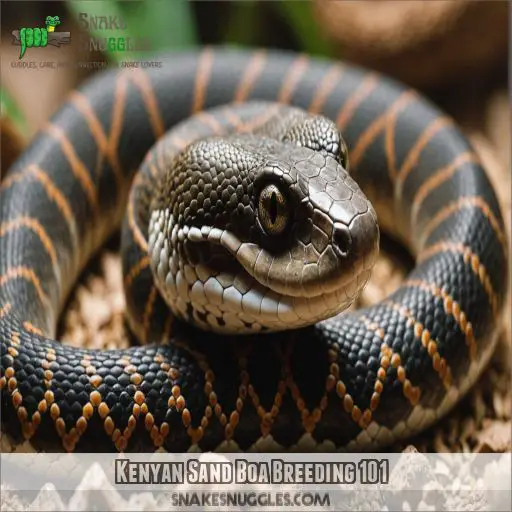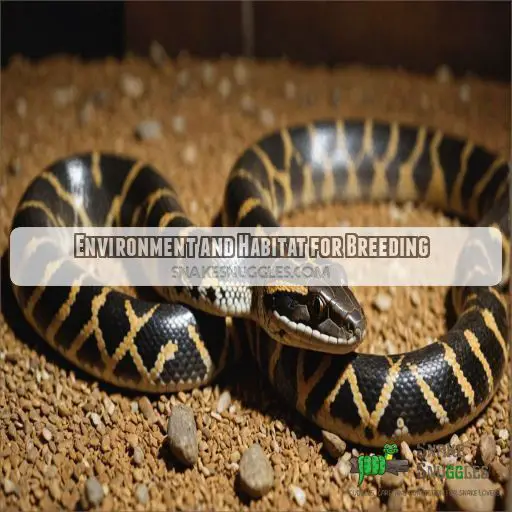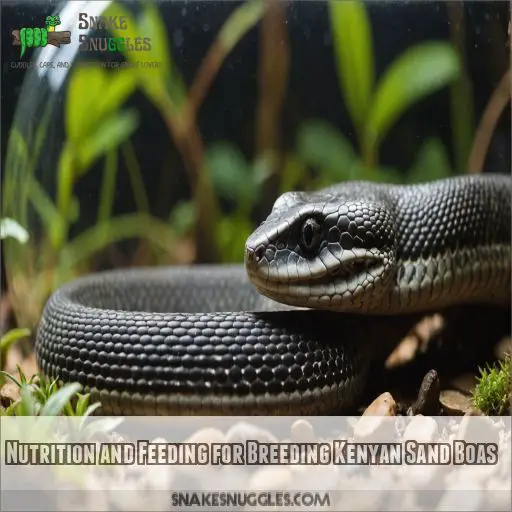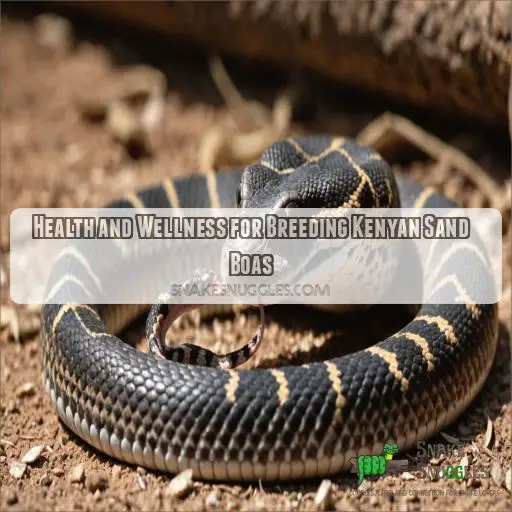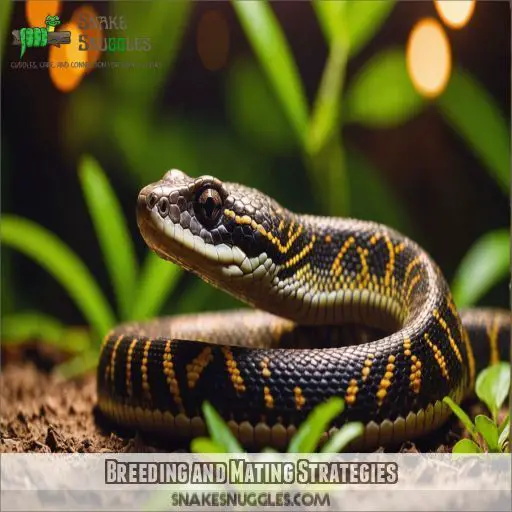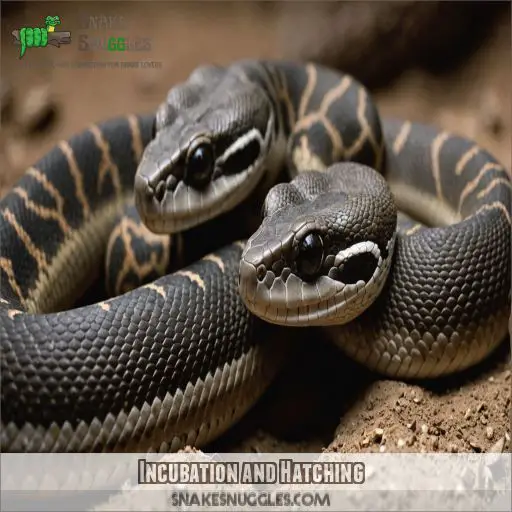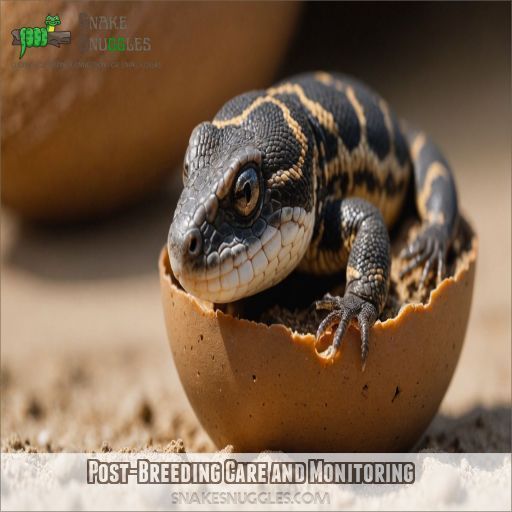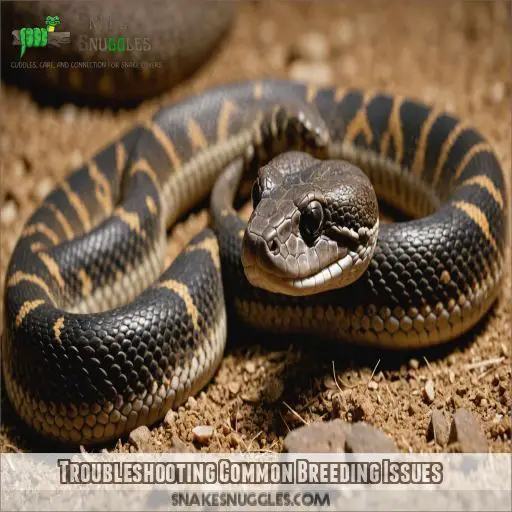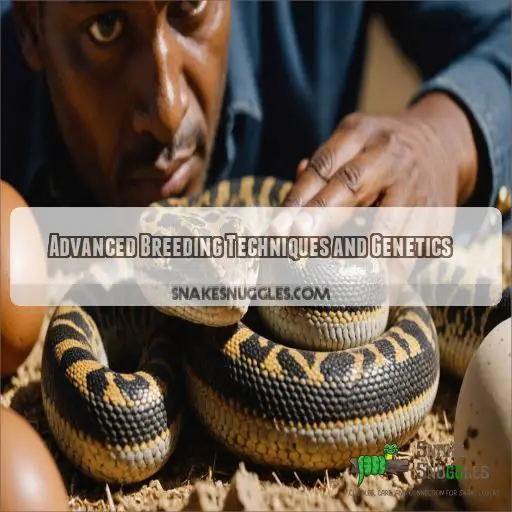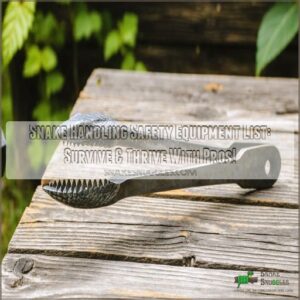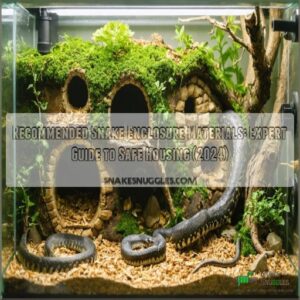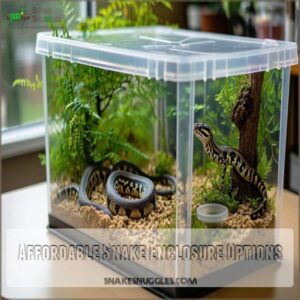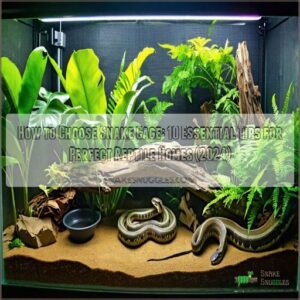This site is supported by our readers. We may earn a commission, at no cost to you, if you purchase through links.
 Ready to dive into the world of Kenyan sand boa breeding? You’re in for a treat!
Ready to dive into the world of Kenyan sand boa breeding? You’re in for a treat!
Breeding these amazing creatures requires a good understanding of their unique traits and needs.
First, you’ll need to pair a healthy, mature female with a stud male, and then wait for the magic to happen.
With a four-month gestation period, your female will give birth to 4-20 live young.
But that’s just the beginning – you’ll need to provide excellent care for your newborns, from feeding to housing.
Table Of Contents
- Key Takeaways
- Kenyan Sand Boa Breeding 101
- Top 9 Essential Products for Breeding Kenyan Sand Boas
- 1. Copperhead Snake Hook Cage Length 33 Inches
- 2. Exo Terra Glass Reptile Terrarium Kit
- 3. Aspen Digs Shavings Bedding
- 4. Reptile Heating Pad with Thermostat
- 5. Reptile Basking Spotlight Bulbs
- 6. Natural Green Sphagnum Moss
- 7. Zoo Med Digital Thermometer Humidity Gauge
- 8. ReptiSafe Terrarium Water Conditioner
- 9. Heavy Duty Reptile Tweezers
- Environment and Habitat for Breeding
- Nutrition and Feeding for Breeding Kenyan Sand Boas
- Health and Wellness for Breeding Kenyan Sand Boas
- Breeding and Mating Strategies
- Incubation and Hatching
- Post-Breeding Care and Monitoring
- Troubleshooting Common Breeding Issues
- Advanced Breeding Techniques and Genetics
- Frequently Asked Questions (FAQs)
- How often do Kenyan sand boas breed?
- What is the gestation period for a Kenyan sand boa?
- How to tell if your sand boa is pregnant?
- Can you keep multiple Kenyan sand boas together?
- How long do Kenyan Sand Boas take to reach maturity?
- Can I breed Kenyan Sand Boas in a group setting?
- What is the ideal age for breeding male Kenyan Sand Boas?
- Do Kenyan Sand Boas require brumation to breed successfully?
- How many offspring can a female Kenyan Sand Boa produce?
- Conclusion
Key Takeaways
- So, you want to be a Kenyan sand boa matchmaker? Well, first you need to pair a healthy, mature female with a stud male, and then wait for the magic to happen – literally, because after a four-month gestation period, your female will give birth to 4-20 live young!
- Temperature control is key when it comes to breeding Kenyan sand boas – aim for a range of 80-90°F (27-32°C) with a basking spot of 95°F (35°C), and don’t forget to maintain 40-50% humidity to keep your snakes happy and healthy.
- If you’re thinking about breeding Kenyan sand boas, you’ll want to know that they don’t require a lot of space – a 24x18x18" tank is ideal – but they do need a deep, sandy substrate for burrowing and some enrichment, like plants and hides, to keep them entertained.
- Line breeding can be a great way to refine desired traits in your Kenyan sand boas, but don’t get too carried away – prioritize genetic diversity and remember that outbreeding can bring in some much-needed hybrid vigor to keep your breeding program fresh and exciting!
Kenyan Sand Boa Breeding 101
You’re about to start an exciting journey of breeding Kenyan Sand Boas.
With the right guidance, you’ll be well on your way to successfully raising healthy, thriving hatchlings.
In this section, we’ll walk you through the basics of Kenyan Sand Boa breeding.
We’ll cover essential topics like breeding season, mating rituals, pregnancy, and birth.
This will help you confidently care for your snakes every step of the way.
Understanding the Breeding Process
As you embark on breeding Kenyan Sand Boas, understanding the process isWhen crucial breeding Kenyan sand boas, you’re essentially matchmaking for snakes. A successful pairing requires a healthy, mature female and a stud male. The female. will incubate Female Ken heryan young Sand internally Bo foras a incub ate4 young internally-month in gest membraneation sac periods, after after a which4 she-month’ll gest giveation birth period to [citation :51-], giving birth to 4-20 live young . You’ll want to ensure you’re prepared to care for these hatchlings, which20 are live independent hatch fromlings birth. and These reach little maturity ones in will about be independent2 from- birth3 and years develop [ quicklycitation,: reaching3 maturity]. in about 2-3 years .
Breeding Season and Mating Rituals
You’re ready to breed your Kenyan Sand Boas. Breeding season typically occurs in the spring and early summer. Here are a few key things to know:
- Mating signals: Males will start to show interest in females by rubbing against them and vibrating their tails.
- Courtship displays: Females will indicate receptivity by relaxing their bodies and opening their cloacas.
- Breeding success: A successful mating will result in a female becoming gravid, but it’s important to monitor their behavior and separate them after mating to prevent stress.
Pregnancy and Gestation Period
Now that your Kenyan Sand Boa is pregnant, it’s important to understand the gestation period, which typically lasts 4 months.
During this time, make sure she gets the right nutrition, a comfortable environment, and keep stress to a minimum.
A healthy female can have a litter size of 4-20 live young.
Keep an eye on her weight, behavior, and provide a suitable birthing environment to help with a smooth delivery.
Birth and Hatchling Care
As a Kenyan Sand Boa breeder, get ready for the ultimate bundle of joy – a clutch of adorable hatchlings!
After a 4-month gestation, your female will give birth to 4-20 live young.
Caring for your hatchlings:
- Feed them appropriately sized prey items.
- Handle them gently.
- Monitor their growth.
Housing and Environment:
- Provide individual housing.
- Maintain the right temperatures and humidity.
- Keep an eye out for health concerns.
Top 9 Essential Products for Breeding Kenyan Sand Boas
Getting started with breeding Kenyan Sand Boas? Having the right gear can make a huge difference between success and, let’s be honest, a whole lot of frustration. In this section, you’ll find the top 9 essential products that’ll help you create a great environment for your boas and create a healthy, stress-free breeding experience for both you and your scaly friends.
1. Copperhead Snake Hook Cage Length 33 Inches
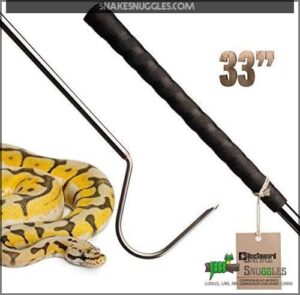
When breeding Kenyan sand boas, you’ll need a reliable snake hook to safely handle your snakes. That’s where the Copperhead Snake Hook Cage Length 33 Inches comes in. Made from high-quality stainless steel and copper, this hook is sturdy, durable, and easy to use. Its balanced design and comfortable grip make it perfect for maneuvering snakes in tight spaces. Trust us, your back (and your snakes) will thank you for investing in this excellent handling tool!
Best For: The Copperhead Snake Hook is best for reptile keepers who need a reliable and safe tool for handling snakes, especially larger species like Kenyan sand boas.
- Sturdy and durable construction for handling heavier snakes.
- Comfortable grip for extended use.
- Great length for cage cleaning and maneuvering snakes in tight spaces.
- No cone-shaped hook end, which could make it slightly harder to pick up snakes at all angles, especially for the 33" length.
- May be too long for smaller snake enclosures.
- No complaints noted in user reviews, but some reviewers suggested a cone-shaped hook end.
2. Exo Terra Glass Reptile Terrarium Kit
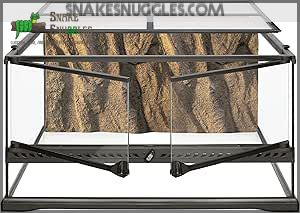
If you’re looking for a good terrarium for your Kenyan Sand Boa, the Exo Terra Glass Reptile Terrarium Kit is a solid choice.
It’s designed to keep your snakes safe and healthy.
The terrarium features:
- Front window ventilation
- Dual doors
- Waterproof bottom
- Stainless steel mesh cover
- Closable inlets for wires and tubing
Just be aware that some customers have reported damage during shipping, so make sure to inspect it carefully before use.
Best For: The Exo Terra Glass Reptile Terrarium Kit is best for reptile owners who are looking for a high-quality, spacious, and well-ventilated terrarium.
- Front window ventilation: Provides excellent airflow for your reptile.
- Dual doors: Makes it easy to access the terrarium for cleaning and feeding.
- Raised bottom: Allows for the use of under-tank heating pads.
- Shipping damage: Some customers have reported receiving damaged terrariums during shipping.
- Foam background: The foam background can be difficult to remove and re-install.
- Expensive: The terrarium is expensive, but many users find it worth the investment.
3. Aspen Digs Shavings Bedding

Looking for the right bedding for your Kenyan Sand Boa? You want something that soaks up moisture, is safe, and lets your snake burrow.
That’s where Aspen Digs Shavings Bedding comes in.
Made from a timber by-product, it’s 100% safe and free from chemicals, oils, and parasites.
Its high absorbency controls humidity and stops odors, making it perfect for your snake’s enclosure.
Plus, it’s dust-free and comes in a resealable bag – a win-win for you and your slithery friend!
Best For: Ideal for burrowing snakes like Kenyan Sand Boas, lizards, and rodents who need a safe, absorbent, and dust-free bedding.
- High Absorbency: Soaks up moisture and controls humidity, keeping your pet’s enclosure clean and dry.
- Safe and Natural: Made from a timber by-product, it’s free from chemicals, oils, and parasites, ensuring a safe environment for your pet.
- Dust-Free: Washed and sieved to remove dust, preventing respiratory issues in your pet.
- Potential Customs Issues: Some customers have reported issues with customs inspections in Mexico.
- Not Suitable for All Snakes: May not be suitable for all types of snakes, so research is important.
- Researched Availability: While available in a resealable bag and through a Subscribe & Save option, ensure it’s readily available in your area.
4. Reptile Heating Pad with Thermostat
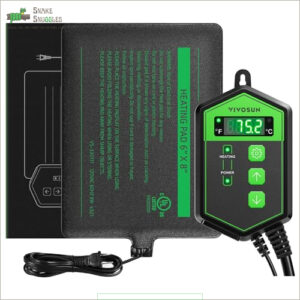
You’re setting up a breeding enclosure for your Kenyan Sand Boas, and temperature control is key. That’s where a reptile heating pad with thermostat comes in. This nifty device helps keep a comfortable temperature range for your snakes, with a digital thermostat that’s easy to use. Look for a UL-approved product with a temperature range of 40-108°F. Just remember to double-check the adhesive and consider an external thermostat for extra convenience. Your Sand Boas will appreciate it!
Best For: Reptile owners looking for a simple way to maintain a consistent temperature range in their enclosures.
- Easy to use: Simple instructions and an easy-to-read digital thermostat.
- Versatile: Works for reptiles, insects, and even plants.
- Secure mounting: Strong adhesive keeps the heat pad in place.
- Thermostat durability: Some users experienced thermostat failure after a month.
- Adhesive strength: The adhesive may loosen over time, requiring additional reinforcement.
- LCD issues: The LCD display can be fragile and may malfunction.
5. Reptile Basking Spotlight Bulbs
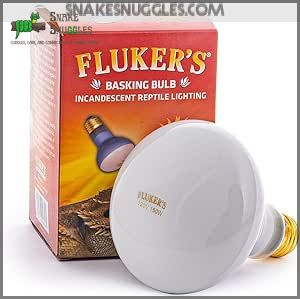
If you’re thinking about breeding Kenyan Sand Boas, you want to give them the best chance at thriving. Reptile basking spotlight bulbs can help. These bulbs, like Fluker’s Repta-Sun, provide the radiant heat your snakes need to regulate their body temperature. But, remember, each species has specific temperature needs, so consult with a vet or reptile care resources to get it just right. Your snakes will thank you, and you’ll be on your way to successful hatchlings!
Best For: This basking bulb is perfect for reptile owners who need to provide a specific heat source for their pets.
- Provides radiant heat for reptiles to regulate their body temperature.
- Relatively affordable.
- Available in bulk for better value.
- Some users report a short lifespan.
- May not be the highest quality option available.
- Doesn’t provide UVB lighting, which is also important for reptile health.
6. Natural Green Sphagnum Moss
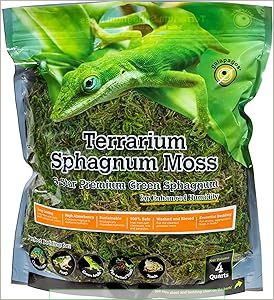
You’re getting ready to breed your Kenyan Sand Boas, and you want the best products for a successful hatch.
You need a really good sphagnum moss for a humid and cozy environment.
Galapagos’ Natural Green Sphagnum Moss is the way to go!
This long-lasting, long-fiber moss is perfect for tropical and wetland terrariums.
It’s sustainably sourced, non-toxic, and holds moisture well.
Your Sand Boas will love it, and so will you – it’s affordable and easy to clean!
Best For: This sphagnum moss is perfect for reptile and amphibian breeders who need a humid and cozy environment for their pets.
- Holds moisture and humidity well.
- Affordable compared to other pet store options.
- Doesn’t attract bugs.
- Comes dry and needs to be re-moisturized.
- May not be suitable for hermit crabs.
- Packaging may be loose and contain a lot of air.
7. Zoo Med Digital Thermometer Humidity Gauge
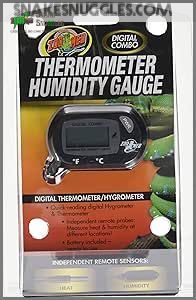
Keeping Kenyan Sand Boas happy and healthy means getting the temperature and humidity just right.
That’s where the Zoo Med Digital Thermometer Humidity Gauge comes in – a must-have for any serious breeder.
With its accurate digital readout and waterproof probe, you can easily monitor your enclosure’s conditions.
Users rave about its long battery life and minimal intrusiveness.
Just be aware of potential suction cup issues and consider alternative mounting methods.
Your Sand Boas will thank you!
Best For: Reptile and amphibian breeders or owners who need accurate temperature and humidity readings for their enclosures.
- Accurate digital readings.
- Long battery life.
- Minimal intrusion into the enclosure.
- Suction cups can be unreliable.
- Probes can be long.
- Display angle can be difficult to read.
8. ReptiSafe Terrarium Water Conditioner
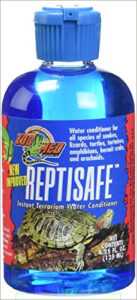
You want the best for your Kenyan Sand Boa hatchlings, and that includes safe drinking water. ReptiSafe Terrarium Water Conditioner is a must-have for breeding success. This instant conditioner removes chlorine, chloramines, and detoxifies ammonia, ensuring your snakes stay hydrated and healthy. With a few easy drops, you’ll have peace of mind knowing your water is safe for your scaly friends. Make ReptiSafe a staple in your breeding routine and give your hatchlings the best start in life .
Best For: ReptiSafe is best for reptile and amphibian owners who want to ensure their pets have safe, clean drinking water.
- Removes harmful chemicals: It eliminates chlorine and chloramines, detoxifying ammonia and nitrites.
- Improves hydration and health: ReptiSafe promotes healthy hydration and slime coat development in amphibians.
- Easy to use: Just a few drops per water change makes it super convenient.
- Packaging issues: The bottle can leak during shipping, so be careful when ordering.
- Limited toxin removal: While it tackles chlorine and ammonia, it doesn’t handle all toxins like heavy metals.
- Not a replacement for good water quality: Even with ReptiSafe, using purified or filtered water is still important.
9. Heavy Duty Reptile Tweezers
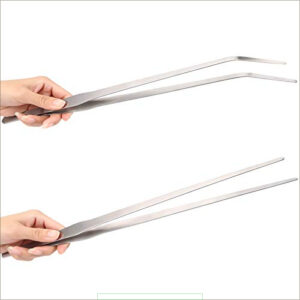
Breeding Kenyan Sand Boas? You’ll need the right tools.
Heavy-duty reptile tweezers are a must-have.
The YYOJ model by unlumm is a top pick.
Here’s why:
- Made from medical-grade stainless steel
- 15-inch length for secure grip
- Perfect for feeding and handling snakes
- Non-slip grip and corrosion-resistant material
- Customers rave about their durability and versatility
Best For: Reptile owners, especially those working with snakes and other larger reptiles.
- Durable and corrosion-resistant.
- Long reach for safe handling.
- Versatile for various tasks.
- May be too large for smaller reptiles.
- Requires careful cleaning after use.
- Can be a bit pricey compared to other tweezers.
Environment and Habitat for Breeding
You’re about to become a master of creating the perfect environment for breeding Kenyan Sand Boas.
It all starts with setting up a really good enclosure that’ll make your snakes feel right at home.
Setting Up a Breeding Enclosure
Now that you’ve got your essential products, it’s time to set up a breeding enclosure! For Kenyan Sand Boas, a 24x18x18" tank is ideal. Choose a substrate that can hold a burrow, like aspen or sand. Add some hiding spots, like rocks or plants, to help your snakes feel secure. Remember, a comfortable environment is key to successful breeding!
Humidity and Temperature Control
Now that your breeding enclosure is set up, let’s talk humidity and temperature control.
Aim for 40-50% humidity and a temperature range of 80-90°F (27-32°C) with a basking spot of 95°F (35°C).
Use heating mats, misting systems, and thermostats to achieve this.
Keep a close eye on temperature and humidity levels to make sure your Kenyan Sand Boas are happy and healthy.
Lighting and UVB Requirements
When it comes to lighting and UVB requirements for Kenyan Sand Boa breeding, you’ll want to get it just right. Use a low-wattage UVB bulb, such as T5 or T8, and aim for a UVB intensity of 0.5-1.0 UVB at 12 inches. This mimics their natural habitat and promotes calcium metabolism, preventing metabolic bone disease in your hatchlings.
Substrate and Decor for Breeding
Now that we’ve got lighting covered, let’s talk substrate and decor for your Kenyan sand boa’s breeding enclosure.
You’ll want a deep, sandy substrate for burrowing.
Add some enrichment like plants and hides.
For a natural look, try adding some rocks or branches.
Just remember, the goal is to create a cozy space that encourages your boas to do what comes naturally.
Nutrition and Feeding for Breeding Kenyan Sand Boas
You’re about to dive into the world of Kenyan Sand Boa breeding, and a key part of this journey is understanding what your snakes need to eat. In this section, you’ll learn about their dietary requirements, feeding schedules, and nutrient-rich foods that will help your breeding program succeed.
Dietary Requirements for Breeding
As a Kenyan Sand Boa breeder, you want your snakes to thrive. A calcium-rich diet with Vitamin D3 supplements is really important for healthy bone growth. Prey size matters, too – feed your snakes prey items that are 1-1.5 times their head diameter. A balanced snake diet is key to a long, happy lifespan, so choose wisely!
Feeding Schedules and Recommendations
Feeding your breeding Kenyan Sand Boas is all about getting the timing right. You want to give them the fuel they need to reproduce without overdoing it. Here are some tips to keep in mind:
- Frequency: Feed adults every 7-10 days, and pregnant females every 5-7 days while they’re expecting.
- Variety: Mix up their prey items every 2-3 feedings to make sure they get a balanced diet.
- Size: Feed prey items that are about 1-1.5 times the diameter of the snake’s head.
Nutrient-Rich Foods for Optimal Health
Now that you’ve got a solid feeding schedule, let’s talk nutrient-rich foods for the best health. You want to provide a varied diet rich in calcium, vitamin D3, and gut-friendly nutrients. Mix up the prey, including mice, rats, and the occasional quail egg. Supplements can also help bridge any nutritional gaps. A healthy gut = a happy snake!
Health and Wellness for Breeding Kenyan Sand Boas
When you decide to breed Kenyan Sand Boas, it’s super important to keep their health in tip-top shape.
This will make things easier for you and your snakes.
If you’re aware of common health issues, take steps to prevent them, and spot signs of illness early, you can give your snakes the best care possible.
This gives your babies the best chance of being healthy.
Common Health Issues in Breeding
When breeding Kenyan Sand Boas, it’s really important to be aware of common health issues that can affect your snakes. These include:
- Respiratory infections from poor enclosure conditions
- Parasites from contaminated food or environments
- Malnutrition from inadequate feeding
- Egg binding in females
- Dehydration from improper humidity levels
Preventative Measures and Care
To prevent health issues, prioritize parasite prevention, strict husbandry practices, and stress management. Regularly inspect your snakes, enclosures, and feeding areas for signs of disease. Consider genetic testing to identify potential problems. Maintain a record of your snakes’ behavior, appetite, and shedding cycles. By being proactive, you’ll be better equipped to handle any health concerns that may arise.
Recognizing Signs of Illness
You’re the first line of defense when it comes to recognizing signs of illness in your Kenyan Sand Boa.
Keep an eye out for lethargy, appetite loss, shedding issues, respiratory problems, or eye discharge.
If your normally feisty Gongylophis colubrinus is acting off, don’t hesitate to seek vet care.
Early intervention can make all the difference in getting your snake back to its sassy self.
Breeding and Mating Strategies
As you start breeding Kenyan sand boas, you’ll need to develop a solid strategy for selecting and pairing your snakes to produce healthy, vibrant offspring. By understanding the principles of selective breeding, line breeding, and outbreeding, you can increase your chances of success and create stunning, one-of-a-kind sand boas that showcase the best of this amazing species.
Selective Breeding for Desired Traits
Now that you’ve got a handle on health and wellness for your Kenyan Sand Boas, it’s time to think about selective breeding for desired traits. This is where you get to play matchmaker and create stunning snake morphs. Here are four key traits to focus on:
- Color: Look for unique patterns and hues to create breathtaking combinations.
-
- Temperament: Aim for calm, docile snakes that make great pets.
-
- Size: Select for good proportions and healthy growth.
-
- Health: Prioritize disease-resistance and strong health in your breeding program.
Line Breeding and Outbreeding
When breeding Kenyan Sand Boas, you’ll need to decide between line breeding and outbreeding. Line breeding can intensify desirable traits, but be aware of inbreeding depression risks. Outbreeding brings genetic diversity and hybrid vigor, making it a great choice for beginners. Weigh the pros and cons carefully to create a breeding strategy that works for you.
Breeding for Color and Pattern
You’re probably wondering how to create those stunning color variations in your Kenyan Sand Boas. Selective breeding is the answer. By understanding pattern genetics, you can develop unique morphs. But remember, with great power comes great responsibility – always prioritize ethics and the well-being of your snakes, and make sure you’re complying with CITES Appendix II regulations.
Incubation and Hatching
In breeding Kenyan Sand Boas, you’ll be learning about incubation and hatching techniques that are specific to this species, including methods for maintaining the right temperature and humidity levels (Source). By mastering these incubation skills, you’ll be able to successfully bring your Kenyan Sand Boa hatchlings into the world, giving them the best possible start in life .
Incubation Techniques and Equipment
Now that you’ve got your female Kenyan Sand Boa gravid, it’s time to set up the perfect incubator.
Choose a reliable model with precise temperature control (around 82-85°F).
Maintain humidity levels at 60-70%.
Select a substrate that retains moisture but won’t collapse, like sphagnum moss.
Make sure there’s good airflow to stop fungus from growing.
Get ready for those adorable hatchlings!
Monitoring Temperature and Humidity
To make sure your Kenyan Sand Boa has a smooth incubation, you’ll need to keep a close eye on the temperature and humidity levels.
Aim for a range of 80-85°F (27-29°C) with 40-50% humidity.
Use tools like thermometers and hygrometers to track any temperature changes.
A stable environment will help your Kenyan Sand Boa feel safe and reduce stress during this important time.
Hatching and Neonate Care
You’ve waited four months for this moment – hatching day!
Once your Kenyan Sand Boa hatchlings emerge, gently place them in a separate, escape-proof enclosure.
Provide a shallow water dish and mist the environment lightly.
Offer a small meal, like a pinkie mouse, within a week.
Monitor their growth, watch for signs of disease, and handle them carefully to prevent stress.
Post-Breeding Care and Monitoring
You’ve successfully navigated the breeding process, but the real challenge begins now – providing the best care for your newborn Kenyan Sand Boas and keeping an eye on their health and wellness. In this section, we’ll walk you through the essential steps to help your tiny hatchlings thrive, from good care and feeding to record-keeping and data tracking.
Monitoring Health and Wellness
Now that your Kenyan Sand Boas have given birth, it’s important to keep an eye on their health and well-being. Watch out for signs of stress, like changes in their eating habits or problems with shedding. Here are a few things to check:
- Enclosure hygiene: Clean the enclosure regularly to prevent parasites.
- Weight management: Keep an eye on how much they’re eating to make sure they’re not losing or gaining too much weight.
- Dietary needs: Make sure you’re giving them the right kind of food they need to stay healthy.
- Snake shedding: Pay attention to how they shed their skin, since irregular shedding can mean there’s something wrong.
Providing Optimal Care for Newborns
Now that you’re monitoring your newborn Kenyan Sand Boas‘ health, it’s time to give them the best care you can.
Make sure they have a warm, humid environment (around 80-85°F and 40-50% humidity) with a shallow water bowl for hydration.
Feed them small, pre-killed prey items every 3-5 days.
Handle them gently, supporting their bodies, and house them in a secure, escape-proof enclosure with a suitable substrate like aspen or reptile carpet.
Record Keeping and Data Tracking
Now that you’ve got your newborn Kenyan Sand Boas, it’s time to get organized! Record keeping and data tracking are super important for breeding success. Log hatch dates, weights, lengths, and feeding schedules to monitor growth. Track parental care, genetic lineage, and health records to refine your breeding strategy. Your future self (and your snakes) will thank you!
Troubleshooting Common Breeding Issues
You’ve carefully prepared the breeding enclosure, painfully selected the perfect breeding pair, and anxiously awaited the arrival of your Kenyan sand boa babies – but things haven’t gone exactly as planned. Don’t worry, troubleshooting common breeding issues is an inevitable part of the process, and with a little patience and know-how, you’ll be back on track in no time.
Dealing With Infertility and Breeding Disputes
Breeding Kenyan sand boas can be a challenge, especially when dealing with infertility and breeding disputes . Hormonal issues, stress factors, or poor mating compatibility can cause problems . Consider genetic testing and seek veterinary advice to identify underlying issues (Source). By addressing these factors, you can minimize disputes and increase the chances of successful breeding .
Overcoming Breeding Challenges
Hey there, fellow snake enthusiast! So, you’re facing some breeding challenges with your Kenyan Sand Boas? Don’t worry, you’re not alone.
Infertility, breeding disputes, and incubation problems can be frustrating.
Let’s troubleshoot together!
Check your snakes’ nutrition, genetics, and social needs.
Sometimes, a simple tweak can make all the difference.
Stay calm, and remember, the snake community is here to help.
Advanced Breeding Techniques and Genetics
You’re about to take your Kenyan Sand Boa breeding skills to the next level by learning advanced techniques.
These techniques will give you a deeper understanding of these snakes’ mysteries.
With them, you’ll have the power to shape the next generations of your breeding program.
From genetic diversity and line breeding to mutations and advanced breeding strategies, you’ll discover the insider secrets that experienced breeders use to create stunning, healthy hatchlings consistently.
Genetic Diversity and Line Breeding
When line breeding Kenyan Sand Boas, you’re walking a fine line between preserving desired traits and risking inbreeding. To avoid this, set clear line breeding goals and prioritize genetic diversity. Regular genetic testing and responsible population management are super important. Remember, as an East African Sand Boa enthusiast, you’re also a steward of this incredible species’ genetic health.
Mutations and Genetic Defects
When breeding Kenyan Sand Boas, genetic testing is really important to identify recessive genes that can lead to health risks.
It’s important to be aware of the risks of producing albino boas, which can be prone to skin problems.
As a responsible breeder, prioritize ethical breeding practices to minimize mutations and genetic defects.
Advanced Breeding Strategies and Techniques
Now that you’ve grasped genetic defects, let’s boost your breeding game with advanced strategies! With selective breeding, you’re the maestro, orchestrating genetic diversity. Line breeding and inbreeding can refine traits, but beware of drawbacks. Outbreeding injects fresh genes, moral of the story: balance is key. Mastering these techniques will get you prized Kenyan Sand Boas (Eryx colubrinus).
Frequently Asked Questions (FAQs)
How often do Kenyan sand boas breed?
You’re curious about the breeding habits of a certain snake species! Well, let me enlighten you – some snakes, like the one in question, typically mate during the spring and early summer, but the frequency varies depending on the species.
What is the gestation period for a Kenyan sand boa?
As you care for your Kenyan sand boa, you’ll want to know that the gestation period for these snakes is about 4 months. This means that after mating, the female will give birth to live young after a relatively short wait!
How to tell if your sand boa is pregnant?
You’re "on a roll" to learn about your sand boa’s pregnancy! Look for physical changes: a swollen belly, weight gain, and a slight pinkish discoloration near the vent area, as well as changes in appetite and behavior.
Can you keep multiple Kenyan sand boas together?
Keeping multiple Kenyan sand boas together? It’s generally not recommended, as they’re naturally solitary animals. Housing them separately makes sure each boa has its own space and reduces stress, promoting a healthier environment .
How long do Kenyan Sand Boas take to reach maturity?
Like a tiny tornado, your Kenyan Sand Boa will whirl through growth stages, reaching maturity in about 2-3 years. Keep a close eye on their development, adjusting care and feeding to meet their changing needs.
Can I breed Kenyan Sand Boas in a group setting?
You can breed Kenyan Sand Boas in a group setting, but it’s important to watch their behavior closely and make sure they get along to keep cannibalism from happening . Remember to research and follow proper breeding guidelines for a successful experience.
What is the ideal age for breeding male Kenyan Sand Boas?
A million years of waiting, but breeding time is finally here! For male Kenyan Sand Boas, the ideal breeding age is around 2-3 years old, when they’ve reached mature size and are in good health.
Do Kenyan Sand Boas require brumation to breed successfully?
If you’re thinking about breeding your Kenyan Sand Boas, you’ll want to know if brumation is necessary. The answer is yes, brumation is recommended to stimulate the production of reproductive hormones (Source).
How many offspring can a female Kenyan Sand Boa produce?
When it comes to reproduction, you’re in for a surprise – a female Kenyan Sand Boa can produce a pretty penny of 4-20 live young, which are approximately 8-10 inches long and independent from birth.
Conclusion
You’ve made it through the ultimate guide to Kenyan sand boa breeding – a feat worthy of a herpetological superhero!
Breeding these incredible creatures requires patience, dedication, and a willingness to learn.
By mastering the art of Kenyan sand boa breeding, you’ll be rewarded with a thriving colony of healthy, happy snakes.
Remember to stay vigilant, keep learning, and always prioritize the well-being of your scaly friends.
Happy breeding!

